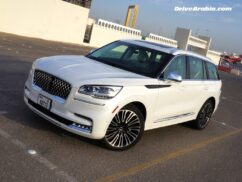2024 Lincoln Aviator
| The Good: – Pretty fast – Cabin trim and features – Ride and handling |
The Bad: – Third-row seating access – Average fuel economy – Limited offroad capabilities |
Aside from maybe the Navigator having some name recognition, Lincoln was a forgotten name that hadn’t been relevant since the Town Car. But in recent years, Ford’s in-house luxury brand has been attempting a comeback, with a heavily revised portfolio of SUV models which are still based on mainstream Ford models, but hide their connection much better than before. After the well-received current-gen Navigator, Lincoln’s next-largest model is the Aviator, a three-row midsize SUV that made a few ripples when it debuted in 2021.
The Aviator is a very handsome crossover SUV, sporting design elements from the Navigator such as a swoopy “floating” roof held up by black pillars. Combined with the chrome mesh-like grille and well-used LED lighting elements, Lincoln has done well in stepping up their design game. There’s even interesting little touches such as the quad exhaust tips, which are kind of real — the actual steel exhaust tips point downward so as not to dirty the faux chrome tips that protrude out of the back bumper. It’s a better option than what the Germans do, with their blocked-off obviously-fake exhaust tips.
Based on the latest Ford Explorer under the skin, you’d never guess its underpinnings just by looking at the exterior or even the interior. The Aviator does its own thing, and this becomes obvious as soon as you see the SUV’s air suspension sitting lower so you can climb in easily, before rising again when you set off.

Inside, the Aviator has a completely unique dashboard, door panels and seats, all covered in soft-touch surfaces and leather, with very few hard plastic panels in lower parts of the cabin.
The infinitely-adjustable multi-piece front seats are uniquely Lincoln, and they even come with individually-extending supports for each of your thighs, aside from massage capability.
Cabin space is decent, and even the third row is useful, although access back there is tight. The layout is slightly compromised due to its rear-wheel-drive based setup, but otherwise it’s not a major loss of space compared to some rivals with front-drive layouts.
All three rows offer a limited but useful number of small-item storage options, although the centre console box is a bit shallow. The boot becomes huge once the third row is folded down.
Ford’s typical 10.1-inch infotainment touchscreen makes an appearance here with minimal changes. It has large text and virtual buttons, making it fairly easy to use, although it is starting to feel dated. Apply Carplay and Android Auto are available, and the first two rows have plenty of ports for plugging in devices. The in-car system’s basic voice controls work well, but it stops working once you use Carplay, and switching screens to adjust vehicle or radio settings can be annoying. The button-operated gear selector takes a good while to get used to as well.
Other cool features include the 12.3-inch LCD gauge cluster, panoramic glass roof, a good 4-zone auto a/c and — in the top Presidential trim — a 28-speaker Revel Ultima 3D audio system that attempts to recreate a concert hall.
Available active safety features include forward collision warning with pedestrian detection and evasive steering assist, automatic emergency braking, lane-keeping, lane-centering and other electronic nannies that use radar and cameras, all working in conjunction with adaptive cruise control. Available passive safety features include a 360-degree camera, rear cross-traffic alert with reverse brake assist and the usual multitude of airbags.

The standard engine is a 3.0-litre turbocharged V6, mated to a 10-speed automatic and all-wheel-drive. Making 400 hp at 5500 rpm and 562 Nm of torque at 3000 rpm, the Aviator is a bit of a rocket, thanks to the turbo engine’s strong low-end torque as well as the 10-speed automatic’s short gears.
There is slight turbo lag from idle, but otherwise the motor is generally responsive. We managed a 0-100 kph time of 6.1 seconds on a Dubai afternoon, but the engine sounds somewhat awful at full throttle.
As-tested fuel economy hovered around 14 litres/100 km (7.1 km/litre) during our time with the car, which isn’t amazing, but isn’t bad either, considering the power output.
The Aviator handles well enough to be entertaining, and even comes with a sport mode dubbed “Excite.” The new platform, combined with the wide 275/40 tyres on 22-inch alloys as well as adaptive suspension on our tester, give the big Aviator more car-like reflexes, with good body control and limited body roll.
The steering is very light and can feel twitchy when trundling around town, but at higher speeds, it firms up and offers a bit of feedback. The brakes are good, with linear pedal feel.
The ride is largely smooth and fairly quiet. It can feel a bit floaty in comfort mode, but that’s fine in long-distance cruising.
Interestingly, the Aviator’s “drive mode” selector has a sand mode of sorts, but it is not an offroader. The ESP turns off automatically and the tyres are wide, but that’s about the extent of the all-wheel-drive Aviator’s offroad readiness. The low-profile rubbers and relatively low ground clearance means you’re limited to flat gravel tracks and the mildest of sandy terrain, although a more experienced driver can probably fool you into thinking it can climb a dune or two without breaking anything.
The Lincoln Aviator is a long-distance mile-muncher for family trips, and extremely adept at its job. The top Presidential trim edges into premium German-badged territory, but a lower-spec trim has a more approachable price if you want to stick to luxury SUVs that are right-sized and city-friendly.
Photos by Mashfique Hussain Chowdhury.
| Price Range: Dh 243,500-326,000 Current Model Introduced in: Body Styles: Engines: Transmissions: Setup: Suspension: |
Brakes: Front: discs Rear: discs Curb Weight: Length: Wheelbase: Top Speed: Test Acceleration 0-100 kph: Observed Test Fuel Economy: |
















There are no comments. Be the first!